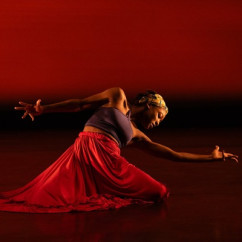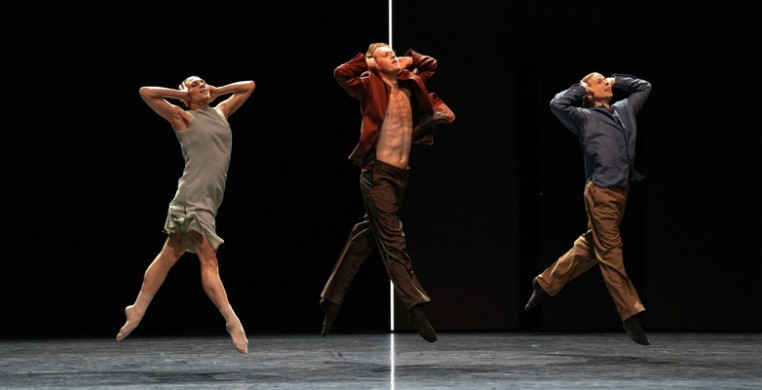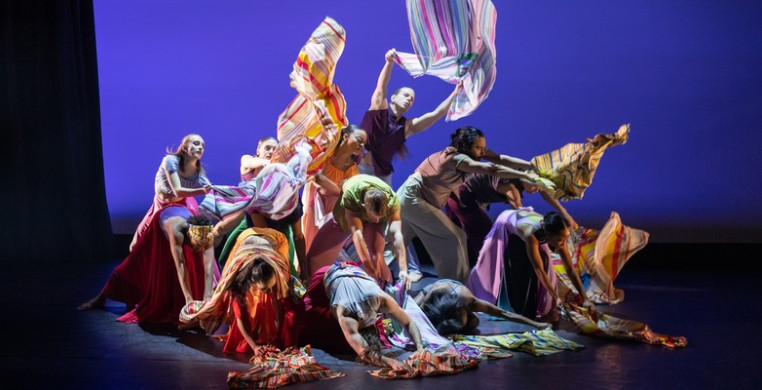Hubbard Street Dance Chicago’s Spring 2024 Season, “Of Joy,” lives up to its title! Joy indeed abounded in the judiciously-curated evening of four works by four choreographers of vastly diverse backgrounds.
.
Maria Torres’ Latin roots characterize much of her musical theatre choreography. Kyle Abraham’s mission to represent Black voices is thematic to his dramatic story-telling. Canadian-American Azure Barton’s classical ballet training underscores the technical range of her choreographic imagination, while Sweden’s John Inger meditates on global dysfunction and a utopian vision for the future. Diversity, indeed!
Diversity has been a hallmark of Hubbard Street since its inception, and never more so than now, under the artistic direction of Linda-Denise Fisher-Harrell, at the helm since 2021.
And yet…There was a unity among three of the four pieces, verging on sameness in movement vocabulary, pace, and dynamic on stage at the Harris Theater, Inger’s “Impasse” being the exception.
Homogeneity in programming can be a deliberate choice, delivering a particular message through different choreographic lenses. Conversely, too much sameness can dull the viewer’s senses, diminishing the impact of each piece, and reducing lasting impressions to a blur. In Hubbard Street’s “Of Joy,” both benefits and deficits were at play.
 "Echoes of Our Ancestors," with Michele Dooley; Photo by Michelle Reid
"Echoes of Our Ancestors," with Michele Dooley; Photo by Michelle Reid
Torres’ “Echoes of Our Ancestors” (2024) was a perfect opener, sunny, swift-paced, and flowing. Composer Philip Hamilton’s score filled the space with the sound of water and rhythmic hand drums, evolving into a driving Afro-Cuban beat. Costume designer Luis Razo’s colorful silk shawls multi-tasked as costumes, props, and set decoration as the dancers tossed them into the air, wrapped them around each other, twirled them, and paraded them overhead. Culottes for both men and women served double duty as props, the fabric seemingly dancing to its own rhapsody.
“Echoes” is told in episodes, alternating full ensemble, small group variations, duets, and solos, all flowing swiftly one into the next. Non-stop breathiness showcased the unique personalities and individual virtuosity of the dancers.
The piece began with African dance forms, gradually merging into modern, ballet and contemporary dance, all to the driving beat of Afro-Cuban drum rhythms. Anchored in the traditional limb and core isolations of Afro-Carribean dance, “Echoes” was reminiscent of Percival Borde, the 20th century Afro-Caribean dancer, choreographer, educator and scholar. But Torres takes it into the next chapter.
Elbow-flapping, knee-knocking, and intricate footwork characterized the introductory sequences. Torres quickly departs from those roots with abandon as she navigates a blend of western theatrical dance that encompasses ballet, modern, contemporary, hip-hop, and ballroom.
The dancers’ energy was centered low in the body, with plenty of pelvic thrusts, percussive physical and vocal exclamations (“Huh!), and seductive fanny rotations. Aja M. Jackson’s geometric lighting design painted the stage floor and cyclorama with geometric designs and a rainbow of color that reflected and enhanced the dancers’ movement. “Echoes” was so exhilarating, it could easily have satisfied as an entire evening, but there was more.
On Friday night, Aaron Choate was the solo dancer in Kyle Abraham’s “Show Pony,” (2018), alternating the role with Cyrie Topete and Alyssia Johnson, Saturday and Sunday respectively. It would have been interesting to see the same choreography on female bodies, as the piece seemed to be about exaggerated femininity, steeped in voguing, the trendy dance form inspired by the fashion runway. In a biting choreographic essay on gender stereotypes, pathos underscored Choate’s electronic “bionic” character.
Lighting designer Nicole Pearce’s geometric lighting defined the changing spatial boundaries of a relationship in Aszure Barton’s “A Duo” (2024). Candy-coated female voices punctuated Miu and Shaolin Mantis’ pulsating music in a dance of courtship, love, and sexual union. With mixed casting in alternating performances, Barton seems to be exploring the universal forces of life that compel us to seek love and the challenges of bonding.
 "IMPASSE" by Johan Inger, with Jacqueline Burnett, Jack Henderson and David Schultz; Photo by Michelle Reid
"IMPASSE" by Johan Inger, with Jacqueline Burnett, Jack Henderson and David Schultz; Photo by Michelle Reid
Johan Inger’s “Impasse” (2020) tells a story of conformity, individuality, rebellion, and the necessity of community. Jacqueline Burnett and David Schultz are the central couple who journey together from the innocence and the delight of mutual discovery through the forces of peer pressure and social conformity, to the need for acceptance of each other’s differences within the community.
The piece is at once playful, sarcastic, cynical, scary, and optimistic, ending on a note of hope: if we love and respect our differences, there’s a chance we can create a better world with room for everyone. Along the way, our characters inhabit smaller and smaller houses. The choreographer’s own scenic design—initially neon-outlines of a large house with a door that opens--spews out a cast of characters ranging from thugs to clowns to agents of evil. As the piece unfolds, successively smaller neon houses appear, until the last house is so small, no one can live in it.
Metaphors abound, but I can only guess at their intended meaning. It didn’t keep me from enjoying the piece, which was immensely entertaining—sweet, provocative, and often funny. Choreographic satire, sarcasm, and buffoonery make for an interesting mix. Whatever your interpretation of the piece, Inger’s sense of whimsy is infectious, and the dancing was divine!
The indisputable highlight of the evening was the company itself! When I interviewed Linda-Denise shortly after she was named Hubbard Street’s 4th artistic director, her vision for the company was to honor its past while forging new ground going forward. That included a commitment to diversity in hiring— of dancers, choreographers, composers, and designers—and expanding on Hubbard Street’s stylistically eclectic repertoire.
“Of Joy” is testimony to that vision. She has invigorated the company with new faces, while capitalizing on the strengths of Hubbard Street’s veteran dancers. As an ensemble, they complement and support one another. As individual dancers, their technical virtuosity and distinctive artistic assets set them in a class by themselves. This season’s company emerges as the strongest I have ever seen them. How lucky we are in Chicago to claim them as our own while sharing them with the rest of the world!
For more information on Hubbard Street Dance Chicago, click the company link below.

